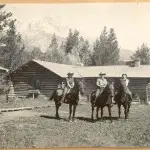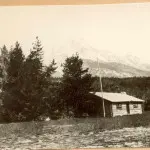Joseph S. Clark, Jr., a future senator of Pennsylvania and mayor of Philadelphia, and Frank R. Williams, a wilderness guide, first met in 1923 on a pack trip. Clark was part of the group that Williams was leading. Like many before him, he quickly fell in love with the Jackson Hole landscape. A fast friendship grew between the two men, who quickly began planning their own dude ranch operation. They decided to focus on high school and college-aged boys, rather than adults or families. This may have been to ensure good numbers, and less competition from the nearby Bar BC and other sought-after dude ranches.
Williams’ father was a land surveyor and began combing over maps for an ideal location, he found a tiny, 12.97-acre lot of forgotten land just south of Jenny Lake. Williams’ wife Emma, settled on the land (Frank had about 400 acres of land near the future Teton Village, and was ineligible to apply for another homestead). Due to homesteading law, and Clark’s impending enrollment at the Harvard Law School that fall, Emma and Frank would fulfill the necessary “proving-up” requirements. They had to cultivate the land, build a cabin and maintain residence for 5 years (thus Emma being the one to file on the homestead, and not Joseph Clark Jr.).
Over the winter, Emma and Frank were busy overseeing the planning for a large main lodge (dining room and kitchen) and twelve small sleeping cabins. Joseph was also busy signing up a group of 19 young boys who would be the first dudes. His connections to the wealthy families in Philadelphia and the success of the Bar BC in the same circles made quick work of enrollment. However, by the spring of 1924, winter was late in receding from the valley. The boys were due to arrive on July 1 and snowbanks prevented construction through mid-May. Despite the mounting workload, and the frenzy to find and house pack horses, by the time the boys arrived, everything was in order. The locals who provided the work were used to this quick turnaround, and were skilled log craftsmen. Two years later in 1926, Clark and Williams purchased an additional 40 acres of land from Jimmy Manges, who ran the adjacent X Quarter Circle X Ranch. Because of the classic partnership of a western wrangler and wealthy eastern Philadelphian, the Double Diamond Dude Ranch enjoyed a high success rate. The westerner provided the know-how and the easterner provided the funds, and clientele. By the next year, they expanded to 27 boys.
The Ranch continued to be successful and grew through the 1930s, with only a $100 deduction in fees during the Depression. Joseph Clark Jr. sold his shares to Harry and Nola Brown, to pursue a career in politics that required his full attention. Clark kept an acre with his private cabin, but his management of the dude ranch ceased. Williams built new log cabins for the boys, replacing the earlier tent platforms. With this change, dudes of all ages were welcome, and it was no longer just a boys ranch. The cabins were updated, more comfortable structures than the tent platforms and positioned for privacy. Hot and cold running water was installed in the main lodge. In the 1940s the ranch underwent another modernization, offering weekly rates rather than season-long. Weekly rates were $25-35, whereas the season rate was $700. This change was designed to appease the new type of tourist looking for less of a summertime commitment to one place, who wanted to see as much as possible during their vacations.
Families often stayed three to six weeks, and the new pricing tier was successful. The ranch continued to attract seasonal families and newcomers until Frank Williams’ death in 1964. The property was sold to Grand Teton National Park, and the Browns held a lease to continue operations. This lasted a few short years; in 1970 they relinquished their lease to the park. The American Alpine Club saw an opportunity and renewed the lease for use as a base of operations for a new type of venture: mountaineering. Jackson Hole quickly became known for the Tetons and the challenges posed by their high peaks. Many mountain climbers from around the world were attracted to the sweeping views the mountains offered. Previously, the Jenny Lake Climbers’ camp had been operating since the 1950s. With the new lease at the old Double Diamond, the climbing community had found a permanent home the valley. The Double Diamond Ranch is still operated today by the American Alpine Club. Tragedy struck in 1985 when the Taggart/Beaver Creek fire destroyed many of the original dude cabins. The main lodge was spared, but 8 buildings were burned to the ground. The National Park Service and the American Alpine Club decided to save the remaining buildings, and rebuilt new facilities. Climbers from around the world still visit Jackson Hole and stay at the Double Diamond Dude Ranch.
Text by Samantha Ford, Director of Historical Research and Outreach


